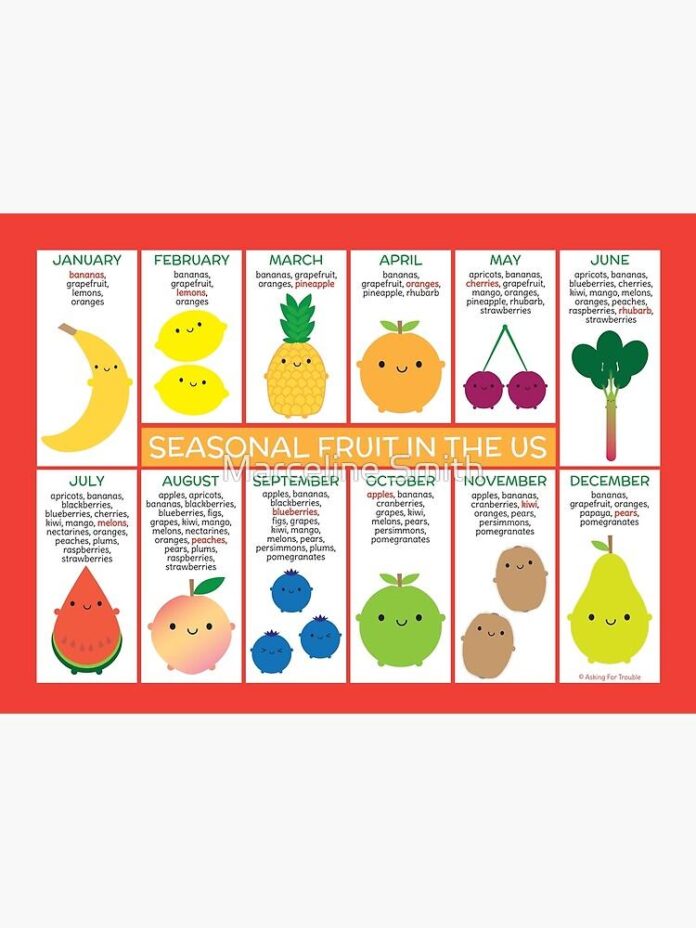In a world of fast food and convenience, is it possible to reconnect with the rhythms of nature through something as simple as the food we eat? Enter the enchanting world of Ayurveda and its timeless wisdom on how to cultivate a harmonious relationship with our bodies and the seasons. Seasonal eating, an essential tenet of Ayurvedic principles, invites us to embrace the ever-changing tapestry of flavors and nutrients that nature offers us throughout the year. In this article, we embark on a journey to explore the Ayurvedic guidelines for a year-round diet, illuminating the path towards a more balanced and wholesome way of nourishing ourselves. Step into a realm where food becomes a conduit for both physical and mental well-being, and let the magic of seasonal eating unfold before your senses.
Understanding the Concept of Seasonal Eating in Ayurveda
Seasonal eating is a key concept in Ayurveda, a traditional system of medicine originating from India. According to Ayurveda, our bodies have different needs depending on the season, and by aligning our diet with the natural cycles of the year, we can optimize our health and well-being.
Ayurvedic guidelines for seasonal eating emphasize the importance of consuming foods that are in sync with the current climate and local environment. This means eating fresh, locally grown produce that is in season. For example, during the hot summer months, Ayurveda recommends light, cooling foods such as cucumbers, watermelon, and mint. In contrast, during the cold winter months, warming foods like root vegetables, soups, and stews are suggested.
- Benefits of Seasonal Eating in Ayurveda:
- Promotes balance and harmony in the body
- Enhances digestion and nutrient absorption
- Supports the body’s natural detoxification processes
- Boosts immunity and overall well-being
- Reduces the risk of seasonal illnesses
By following Ayurvedic guidelines for seasonal eating, we can not only nourish our bodies but also connect with the natural world around us. This approach to diet encourages mindfulness and respect for the earth’s cycles, leading to a more sustainable and holistic way of nourishing ourselves.
| Fruit | Season | Benefits |
|---|---|---|
| Mango | Summer | Hydrating and cooling |
| Apples | Fall | Rich in antioxidants |
| Pomegranate | Winter | Immune-boosting |
| Strawberries | Spring | Vitamin C-rich |

Harmonizing Your Diet with Nature’s Rhythms for Optimal Health
The concept of seasonal eating is deeply rooted in Ayurveda, an ancient Indian system of medicine and healing. Ayurveda recognizes that just as nature goes through cycles of change throughout the year, our bodies also experience these natural rhythms. By harmonizing our diet with the seasons, we can support optimal health and well-being.
Ayurvedic guidelines for seasonal eating emphasize the importance of consuming foods that are locally and seasonally available. Each season offers a unique array of fruits, vegetables, and herbs that are perfectly suited to our body’s needs at that particular time. By incorporating these seasonal foods into our diet, we can take advantage of their abundance of vital nutrients and energetic qualities.
- Spring: As the world comes alive with new growth, it is a time for light, cleansing foods. Emphasize fresh, leafy greens, sprouts, and bitter vegetables like dandelion greens and artichokes. Now is also the perfect time to use warming spices like ginger and turmeric to support digestion.
- Summer: With the heat of summer, it is important to stay hydrated and cool. Enjoy juicy fruits like watermelon, berries, and mangoes. Opt for cooling foods like cucumbers, coconut water, and fresh mint. Avoid heavy, oily foods and choose lighter options like salads and raw food dishes.
| Season | Foods | Health Benefits |
|---|---|---|
| Fall | Pumpkin | Rich in vitamins A and C, supports eye health and immunity |
| Pomegranate | High in antioxidants, reduces inflammation and protects against heart disease | |
| Root vegetables (carrots, beets, sweet potatoes) | Nourishes the body and grounding energy |
Fall brings cooler temperatures and a shift towards grounding, nourishing foods. Incorporate hearty root vegetables like carrots, beets, and sweet potatoes into your meals. These vegetables are rich in essential vitamins and minerals, providing support for your immune system and enhancing overall health. Additionally, indulge in pomegranates, which are packed with antioxidants that contribute to reduced inflammation and improved heart health.
By aligning our diet with nature’s rhythms, we can tap into the wisdom of Ayurveda and nourish our bodies in a way that supports optimal health and vitality throughout the year. So next time you’re at the grocery store or farmer’s market, tune in to what nature is offering and embrace the seasonal abundance for a harmonious year-round diet.

Specific Dietary Recommendations for Each Season in Ayurveda
In Ayurveda, an ancient Indian system of medicine, seasonal eating is considered essential for maintaining balance and optimal health. Each season brings its own set of qualities that influence our body and mind. By aligning our diet with the changing seasons, we can support our overall well-being and enhance our body’s natural ability to heal. Ayurveda provides specific dietary recommendations for each season, tailoring our food choices and eating habits accordingly.
Spring:
- Favor light, warming, and easily digestible foods to counter the heavy and damp qualities of spring.
- Incorporate freshly cooked vegetables, whole grains, and spices like ginger and turmeric to support digestion and detoxification.
- Avoid heavy dairy products and instead opt for lighter dairy options like goat’s milk or almond milk.
- Include herbs such as dandelion and nettle to promote cleansing and rejuvenation.
Summer:
- Focus on cooling foods to balance the heat of summer.
- Enjoy juicy fruits, cucumbers, coconut water, and grains like barley and quinoa.
- Avoid heavy, oily, and spicy foods that can further increase internal heat.
- Keep yourself hydrated by drinking plenty of water, herbal infusions, or coconut water.
| Dietary Recommendations | Spring | Summer |
|---|---|---|
| Favor | Light, warming, and easily digestible foods | Cooling foods |
| Avoid | Heavy dairy products | Heavy, oily, and spicy foods |
| Incorporate | Freshly cooked vegetables, whole grains, ginger, turmeric | Juicy fruits, cucumbers, coconut water, barley, quinoa |
| Include | Dandelion, nettle | N/A |

Creating Balance through Seasonal Eating: Key Principles and Tips
One of the fundamental principles of Ayurveda is the belief that our bodies and minds are closely connected to the natural world around us. Just as the seasons change, so too should our diets. By embracing the concept of seasonal eating, we can achieve balance and harmony within ourselves and with the world. Here are some key principles and tips to help you navigate your year-round diet.
Eat with the seasons: The first and most important principle of seasonal eating is to consume foods that are naturally available during specific times of the year. In the spring, opt for fresh greens, sprouts, and berries to help cleanse and rejuvenate your body. Summer calls for cooling and hydrating foods like cucumbers, watermelons, and coconut water. As we transition into autumn, prioritize warming and grounding foods such as root vegetables and hearty soups. Finally, in the winter, focus on nourishing foods like soups, stews, and cooked grains to support your body through the colder months.
- Balance your doshas: Ayurveda recognizes three doshas—Vata, Pitta, and Kapha—that influence our physical and mental well-being. Each dosha relates to specific elements and qualities, and understanding your predominant dosha can help guide your dietary choices. For example, if you have a Vata imbalance, which is associated with coldness and dryness, incorporating warm, grounding foods like cooked grains and root vegetables can bring balance. On the other hand, if you have a Pitta imbalance, you might benefit from cooling foods like sweet fruits and leafy greens.
- Support local farmers: Seasonal eating not only benefits your health but also supports local farmers and the environment. By choosing foods that are in season, you are more likely to find them locally sourced, reducing the carbon footprint associated with transportation. Additionally, purchasing directly from local farmers can help strengthen the local economy and foster a sense of community.
Key Takeaways
As we bid adieu to the final lines of this article on Seasonal Eating: Ayurvedic Guidelines for a Harmonious Year-Round Diet, we find ourselves drifting away into a realm where our connection with nature intertwines seamlessly with our dietary choices. Like a symphony orchestrated by the harmonious whispers of ancient wisdom, Ayurveda guides us through the graceful dance of the seasons, allowing us to embrace the ever-changing rhythms of the natural world.
Immersing ourselves in this enchanting journey, we discover the profound significance of aligning our diet with the changing tapestry of the year. From the vibrant hues of spring’s tender greens to the nurturing warmth of summer’s golden bounties, each season offers a unique opportunity to nourish both our bodies and souls.
With a gentle touch, Ayurveda reminds us to savor the delicate flavors of life’s abundant offerings. It encourages us to shed our modern disconnection and embrace the cyclical nature of existence. Through mindful awareness of nature’s gifts, we awaken our senses to the whispers of the wind, the fragrance of blooming flowers, and the crispness of autumn’s falling leaves. In listening to these subtle serenades, we forge a deeper connection to the world around us, and in turn, to our own selves.
Here, in this vast tapestry of Ayurvedic principles, we are urged to cherish and embrace the nourishing potential of each season. Like a perfectly balanced orchestra, our plates become a palette of seasonal delights, effortlessly blending the energies of nature’s bounty with our own unique constitutions. Just as the earth and seasons transform, so too do our bodies, urging us to harmonize our diets and rhythms with the ever-changing world around us.
As the final echoes of this timeless wisdom reverberate through our minds, we are reminded that the path to a harmonious year-round diet lies not in rigid rules or stringent restrictions, but instead in the gentle ebb and flow of seasonal energies. By embracing the teachings of Ayurveda, we unlock the key to a balanced, nourished existence that dances in synchrony with the pulse of nature itself.
And so, as we step away from these words and venture back into our daily lives, let us carry with us the knowledge of Ayurveda’s ancient whispers. Let us savor the flavors of each season, honor the gentle guidance of our bodies, and embark on a lifelong journey of harmonious nourishment. In doing so, we may unlock the symphony of well-being, allowing us to live in seamless harmony with not only the world around us, but with the very essence of our vibrant, interconnected selves.



